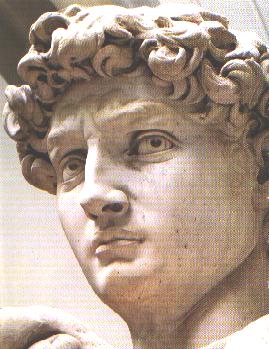 Originally
it was a block of marble, an enormous block of white
marble, belonging to the Opera del Duomo of Florence,
excavated with the intention of carving out a giant: a
David or a Prophet for one of the buttresses of the
Cathedral of Santa Maria del Fiore. Initially the work
was entrusted to the sculptor Agostino di Duccio (1462)
and later to Antonio Rossellino (1476) but both were
forced to give up in face of the enormous technical
difficulties. The block of marble was not compact, it was
riddled with veins and above all it was tall and narrow,
more suitable for slender gothic statues than for the
muscular active representations of Renaissance heroes.
Leonardo da Vinci was also approached, and although he
had a considerable experience in bronze sculpture, the
artistic genius declined the offer and the roughly hewn
block of marble was courtyard of the Originally
it was a block of marble, an enormous block of white
marble, belonging to the Opera del Duomo of Florence,
excavated with the intention of carving out a giant: a
David or a Prophet for one of the buttresses of the
Cathedral of Santa Maria del Fiore. Initially the work
was entrusted to the sculptor Agostino di Duccio (1462)
and later to Antonio Rossellino (1476) but both were
forced to give up in face of the enormous technical
difficulties. The block of marble was not compact, it was
riddled with veins and above all it was tall and narrow,
more suitable for slender gothic statues than for the
muscular active representations of Renaissance heroes.
Leonardo da Vinci was also approached, and although he
had a considerable experience in bronze sculpture, the
artistic genius declined the offer and the roughly hewn
block of marble was courtyard of the  forgotten in the Opera del Duomo
until 1501. These were crucial years for the Florentine
Republic. The Medici family had been expelled (1494) and
the gonfalonier Pier Soderini was recalling the artists
to give new impetus and backing to his government and to
further the intellectual and artistic revival of the
city. Michelangelo, informed by friends of the
possibility of acquiring the great abandoned block of
marble, also came back. For him, naturally obstinate,
this opportunity of measuring himself against a
generation of sculptors who had failed, together with the
difficulties created by the previous "mutilations
and damage", must have constituted a particularly
intriguing challenge. Michelangelo was officially
commissioned on 16 August 1501 at the age of 26. The
enterprise took off immediately, and at the beginning of
September the artist began testing the the block. In forgotten in the Opera del Duomo
until 1501. These were crucial years for the Florentine
Republic. The Medici family had been expelled (1494) and
the gonfalonier Pier Soderini was recalling the artists
to give new impetus and backing to his government and to
further the intellectual and artistic revival of the
city. Michelangelo, informed by friends of the
possibility of acquiring the great abandoned block of
marble, also came back. For him, naturally obstinate,
this opportunity of measuring himself against a
generation of sculptors who had failed, together with the
difficulties created by the previous "mutilations
and damage", must have constituted a particularly
intriguing challenge. Michelangelo was officially
commissioned on 16 August 1501 at the age of 26. The
enterprise took off immediately, and at the beginning of
September the artist began testing the the block. In  solidity and quality of October
he had a "turata di tavole" built around it, a
kind of enclosure made of wood and masonry to protect and
conceal his work. He must have made rapid progress since
on 25 January 1504, after little more than two years, the
enormous David was practically complete. solidity and quality of October
he had a "turata di tavole" built around it, a
kind of enclosure made of wood and masonry to protect and
conceal his work. He must have made rapid progress since
on 25 January 1504, after little more than two years, the
enormous David was practically complete.The work
inspired considerable curiosity and admiration among the
citizens, while to the artistic community which had known
the original marble it seemed like "one raised from
the dead". But the statue also kindled envy and
criticism, and was from the very start the target of
fanaticism and vandalism. In the biography devoted to
Michelangelo, Giorgio Vasari relates how Pier Soderini,
while on the whole full of praise for the statue,
considered the nose too big. Pretending to heed him and
to want to re-chisel the nose, the sculptor climbed onto
the scaffolding 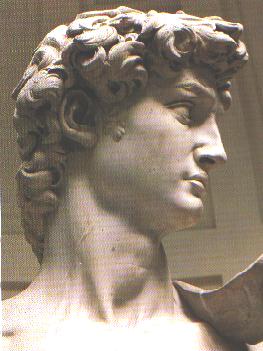 judiciously
scattering some marble dust which he had hidden in his
fist. Only then did the gonfalonier grant his definitive
approval, and, "as recompense", four hundred
scudos. Given the exceptional nature of the work, a
lively debate arose about its most suitable location: it
was unthinkable to sacrifice this superb nude, moulded so
as to be appreciated in the round, by flattening it
against a wall, even if it were the wall of the imposing
Duomo of Florence. A committee of the most famous artists
of the time was therefore appointed. Giuliano da the now
elderly Leonardo da Vinci suggested setting the statue up
in the Sangallo and Loggia della the back wall darkened
to enhance the whiteness of the marble. This Signoria,
with solution, consistent with Leonardo’s own
studies of atmosphere and subtle shading was not,
however; consistent with Michelangelo’s ideas. His
David was vibrant judiciously
scattering some marble dust which he had hidden in his
fist. Only then did the gonfalonier grant his definitive
approval, and, "as recompense", four hundred
scudos. Given the exceptional nature of the work, a
lively debate arose about its most suitable location: it
was unthinkable to sacrifice this superb nude, moulded so
as to be appreciated in the round, by flattening it
against a wall, even if it were the wall of the imposing
Duomo of Florence. A committee of the most famous artists
of the time was therefore appointed. Giuliano da the now
elderly Leonardo da Vinci suggested setting the statue up
in the Sangallo and Loggia della the back wall darkened
to enhance the whiteness of the marble. This Signoria,
with solution, consistent with Leonardo’s own
studies of atmosphere and subtle shading was not,
however; consistent with Michelangelo’s ideas. His
David was vibrant 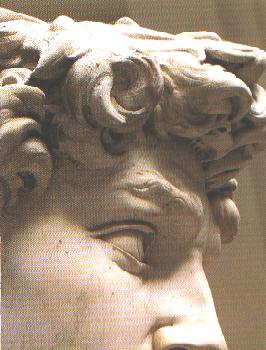 with a
life of his own, and could certainly not be adapted for
insertion in a "niche, blackened behind like some
miserable chapel". Michelangelo was not present at
the discussion but his desire, voiced by the herald of
the Signoria, was to place his "giant"
– as the Florentines called it - in front
of the Palazzo della Signoria, the civic heart of the
city, or at most in the courtyard of the Palazzo itself.
The choice fell to the front of the Palazzo beside the
great doorway: the severe rusticated facade would
admirably set off the physical vitality of the David
plastically defined in the white marble. with a
life of his own, and could certainly not be adapted for
insertion in a "niche, blackened behind like some
miserable chapel". Michelangelo was not present at
the discussion but his desire, voiced by the herald of
the Signoria, was to place his "giant"
– as the Florentines called it - in front
of the Palazzo della Signoria, the civic heart of the
city, or at most in the courtyard of the Palazzo itself.
The choice fell to the front of the Palazzo beside the
great doorway: the severe rusticated facade would
admirably set off the physical vitality of the David
plastically defined in the white marble.
It was no easy matter to transport the heavy statue,
which was more than four metres high, to Piazza Signoria,
passing through the narrow and tortuous streets of
Florence. Michelangelo and some of his ingenious friends
designed and built a special "castle" with
winches and sturdy ropes 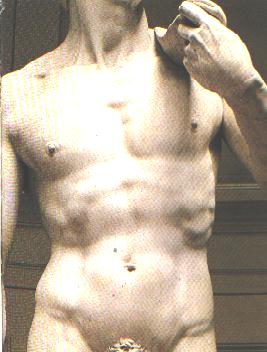 for the
purpose. The journey took four days and to avoid acts of
vandalism the statue was policed night and day by special
guards; in spite of this it was the target of
stone-throwing on the part of certain young louts (sadly,
history repeats itself) who paid for their disrespect
with a week of prison. On 8 June 1504 the
"giant" reached the steps of the Palazzo della
Signoria, but it was not raised onto its marble base and
presented to the Florentines until 8 September; the feast
of Our Lady. The crowd gathered in the square was
impressed by the beauty of the colossal nude, but also by
the iconographic originality. The Davids sculpted up
until then had been generally inspired by the Biblical
text, figures of young men clothed in tunics or drapery.
A previous illustrious nude was Donatello’s bronze
(now in the Bargello Museum), but with a delicately
adolescent body, adorned in the ancient manner with
sandals, for the
purpose. The journey took four days and to avoid acts of
vandalism the statue was policed night and day by special
guards; in spite of this it was the target of
stone-throwing on the part of certain young louts (sadly,
history repeats itself) who paid for their disrespect
with a week of prison. On 8 June 1504 the
"giant" reached the steps of the Palazzo della
Signoria, but it was not raised onto its marble base and
presented to the Florentines until 8 September; the feast
of Our Lady. The crowd gathered in the square was
impressed by the beauty of the colossal nude, but also by
the iconographic originality. The Davids sculpted up
until then had been generally inspired by the Biblical
text, figures of young men clothed in tunics or drapery.
A previous illustrious nude was Donatello’s bronze
(now in the Bargello Museum), but with a delicately
adolescent body, adorned in the ancient manner with
sandals, 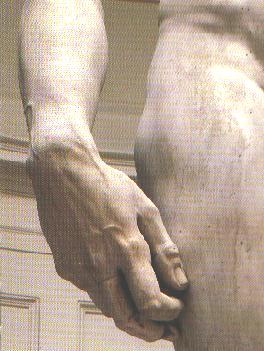 sword and helmet. All
the Davids had, however, been instructively represented
with the macabre trophy of the severed head of Goliath at
their feet. Michelangelo had instead conceived the image
of a vigorous man, totally naked like an ancient hero or
athlete with a glance which reveals a profound confidence
in his own capacity. Because of his demonstrable physical
and moral force, the David immediately came to embody in
the imagination of the Florentines a symbol of civil
virtue and a warning for the enemies of freedom.
Subsequently even the academics have almost unanimously
affirmed this civic quality in the David, while advancing
different interpretations. Some have found links with the
thought of Dante, others with the sermons of Savonarola,
yet others with Neoplatonic thought. Most compelling is
the theory which sees the "giant" uniting sword and helmet. All
the Davids had, however, been instructively represented
with the macabre trophy of the severed head of Goliath at
their feet. Michelangelo had instead conceived the image
of a vigorous man, totally naked like an ancient hero or
athlete with a glance which reveals a profound confidence
in his own capacity. Because of his demonstrable physical
and moral force, the David immediately came to embody in
the imagination of the Florentines a symbol of civil
virtue and a warning for the enemies of freedom.
Subsequently even the academics have almost unanimously
affirmed this civic quality in the David, while advancing
different interpretations. Some have found links with the
thought of Dante, others with the sermons of Savonarola,
yet others with Neoplatonic thought. Most compelling is
the theory which sees the "giant" uniting 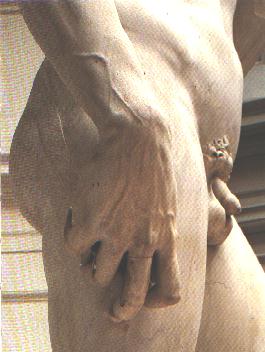 within himself the qualities of
David, the heroic biblical defender of the faith and of
justice, and those of the figure of Hercules in classical
mythology, symbol of strength sustained by intelligence. within himself the qualities of
David, the heroic biblical defender of the faith and of
justice, and those of the figure of Hercules in classical
mythology, symbol of strength sustained by intelligence.
After an act of vandalism which the statue suffered in
1527, Duke Cosimo I had it restored in 1543. Considering
the civic significance of the statue, it might seem
strange that the very monarch who had suppressed or
undermined the power of the democratic institutions of
the Republic contributed to its restoration. The
duke’s gesture, as well as expressing a sincere
appreciation of Michelangelo, was an integral part of his
political strategy. The figure of Hercules had been
exalted since the times of Lorenzo il Magnifico, and
Cosimo himself had more than once compared the acts of
his government to the "Labours" of the mythical
hero. He did not therefore attempt to distance the David
from the palace, 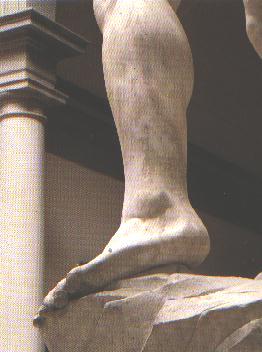 which
had in the meantime become his residence; on the contrary
in ordering its restoration he put himself forward as the
ideal restorer of civil peace. His ambiguity is revealed
in his ordering of other colossi to place alongside it in
the attempt to dilute its presence. which
had in the meantime become his residence; on the contrary
in ordering its restoration he put himself forward as the
ideal restorer of civil peace. His ambiguity is revealed
in his ordering of other colossi to place alongside it in
the attempt to dilute its presence.
Exposed to the elements for centuries, by the mid
nineteenth century the fragile and porous marble of the
David was considerably deteriorated. In view of the
fourth centenary of the artist’s birth, it was
decided to remove the work to the Accademia delle Belle
Arti. In 1882 it was placed within a covered
neo-Renaissance style tribune designed by the architect
De Fabris, while a replica made by the copyist Arrighetti
was put in its original position in Piazza Signoria. The
removal to the Museum had the result of confirming its
superiority in comparison to other statues, and, although
abstracted from the civic environment, 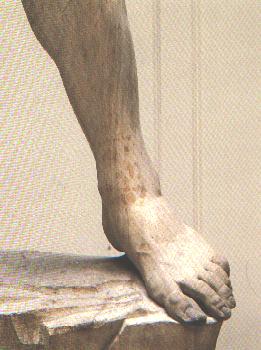 it undoubtedly gained in terms
of fame. An act of vandalism on the part of a maniac in
September 1991, who attacked the toes of the left foot
with a hammer; is an extreme example of the cult, or
worse, of fanaticism which has grown up around the David.
By now well rooted in the collective imagination as an
ideal of perfection, Michelangelo’s David is the
best-known sculpture in the world, a symbol of the art of
all time. The first impression is that of a colossal
naked body of an ancient athlete, or of a classically
designed pagan god, perfect in anatomical form and proud
of glance. But we must not stop at this first appearance;
we must approach the work gradually, slowly circling it
to discover from a multitude of angles, the many men,
heroes and myths that it contains. The sculpture we have
in front of us does not show a youth in a static, relaxed
and triumphant pose, it undoubtedly gained in terms
of fame. An act of vandalism on the part of a maniac in
September 1991, who attacked the toes of the left foot
with a hammer; is an extreme example of the cult, or
worse, of fanaticism which has grown up around the David.
By now well rooted in the collective imagination as an
ideal of perfection, Michelangelo’s David is the
best-known sculpture in the world, a symbol of the art of
all time. The first impression is that of a colossal
naked body of an ancient athlete, or of a classically
designed pagan god, perfect in anatomical form and proud
of glance. But we must not stop at this first appearance;
we must approach the work gradually, slowly circling it
to discover from a multitude of angles, the many men,
heroes and myths that it contains. The sculpture we have
in front of us does not show a youth in a static, relaxed
and triumphant pose, 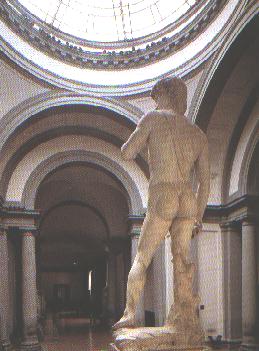 nor a
warrior caught in the strain of battle, as he was wont to
be described with anatomical virtuosity in the second
half of the fifteenth century. David, the young Jewish
shepherd is for Michelangelo an already mature man, and
the artist depicts him in the moment before the launching
of the stone with which he is to strike the Philistine
giant, at a climax of mental concentration and physical
tension. If, without embarrassment, we try to imitate his
posture, and with legs slightly apart put our weight on
the right, the left knee flexes forwards almost
automatically, creating an attitude of
"reflection" which raises the left shoulder and
the right buttock. Up to this point the body remains
balanced. Now let’s pretend that we are grasping the
sling (a catapult with a leather band) which is resting
on our shoulder, in our left hand, and gripping a stone
in our right, the wrist tensely nor a
warrior caught in the strain of battle, as he was wont to
be described with anatomical virtuosity in the second
half of the fifteenth century. David, the young Jewish
shepherd is for Michelangelo an already mature man, and
the artist depicts him in the moment before the launching
of the stone with which he is to strike the Philistine
giant, at a climax of mental concentration and physical
tension. If, without embarrassment, we try to imitate his
posture, and with legs slightly apart put our weight on
the right, the left knee flexes forwards almost
automatically, creating an attitude of
"reflection" which raises the left shoulder and
the right buttock. Up to this point the body remains
balanced. Now let’s pretend that we are grasping the
sling (a catapult with a leather band) which is resting
on our shoulder, in our left hand, and gripping a stone
in our right, the wrist tensely  clenched like that of the
statue, and move the left foot forward (as can be clearly
observed from the back view of the statue). This position
cannot be held for more than a moment... there follows
immediately a transfer of weight to the ball of the left
foot, the twisting of the trunk and the launch of the
stone in the direction upon which the figure’s
glance is focused. The head set upon the strained neck is
turned, as if abruptly, towards the left (in medieval
illustration danger always approached from this side).
It’s not easy to speak of the beauty of David’s
face. To appreciate his expression we have to circle him
slowly, discovering at each step and from each angle what
he reveals: not a single face, but rather a series of
faces, of increasing intensity. Standing in front of the
statue we see only the classic profile conveying a sense
of thoughtful composure. But when we move around it we
observe how this expression is intensified, clenched like that of the
statue, and move the left foot forward (as can be clearly
observed from the back view of the statue). This position
cannot be held for more than a moment... there follows
immediately a transfer of weight to the ball of the left
foot, the twisting of the trunk and the launch of the
stone in the direction upon which the figure’s
glance is focused. The head set upon the strained neck is
turned, as if abruptly, towards the left (in medieval
illustration danger always approached from this side).
It’s not easy to speak of the beauty of David’s
face. To appreciate his expression we have to circle him
slowly, discovering at each step and from each angle what
he reveals: not a single face, but rather a series of
faces, of increasing intensity. Standing in front of the
statue we see only the classic profile conveying a sense
of thoughtful composure. But when we move around it we
observe how this expression is intensified, 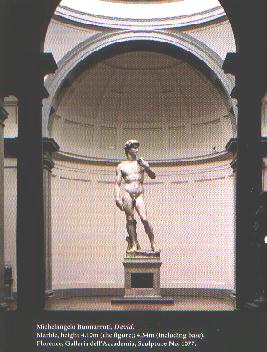 contracted to the point of
menace in the glance directed at the enemy. What we have
before us is not therefore a detached and heroic
attitude, but one that is much more human and intimate.
The very defects contribute to this earthly dimension: as
one gets closer, in fact, David’s head and hands
begin to appear out of proportion. This is an effect
deliberately designed to accentuate those parts of the
body connected with Thought and Action. Had it been
executed according to the classical canons the face would
never have shown the same intensity, and the power of the
hands would have vanished. Although Michelangelo had a
profound knowledge of anatomy, based on his studies of
antiquity and real life observation, he goes beyond
theoretical rules, elaborating and disregarding them to
highlight moral expression. contracted to the point of
menace in the glance directed at the enemy. What we have
before us is not therefore a detached and heroic
attitude, but one that is much more human and intimate.
The very defects contribute to this earthly dimension: as
one gets closer, in fact, David’s head and hands
begin to appear out of proportion. This is an effect
deliberately designed to accentuate those parts of the
body connected with Thought and Action. Had it been
executed according to the classical canons the face would
never have shown the same intensity, and the power of the
hands would have vanished. Although Michelangelo had a
profound knowledge of anatomy, based on his studies of
antiquity and real life observation, he goes beyond
theoretical rules, elaborating and disregarding them to
highlight moral expression.
|

 Originally
it was a block of marble, an enormous block of white
marble, belonging to the Opera del Duomo of Florence,
excavated with the intention of carving out a giant: a
David or a Prophet for one of the buttresses of the
Cathedral of Santa Maria del Fiore. Initially the work
was entrusted to the sculptor Agostino di Duccio (1462)
and later to Antonio Rossellino (1476) but both were
forced to give up in face of the enormous technical
difficulties. The block of marble was not compact, it was
riddled with veins and above all it was tall and narrow,
more suitable for slender gothic statues than for the
muscular active representations of Renaissance heroes.
Leonardo da Vinci was also approached, and although he
had a considerable experience in bronze sculpture, the
artistic genius declined the offer and the roughly hewn
block of marble was courtyard of the
Originally
it was a block of marble, an enormous block of white
marble, belonging to the Opera del Duomo of Florence,
excavated with the intention of carving out a giant: a
David or a Prophet for one of the buttresses of the
Cathedral of Santa Maria del Fiore. Initially the work
was entrusted to the sculptor Agostino di Duccio (1462)
and later to Antonio Rossellino (1476) but both were
forced to give up in face of the enormous technical
difficulties. The block of marble was not compact, it was
riddled with veins and above all it was tall and narrow,
more suitable for slender gothic statues than for the
muscular active representations of Renaissance heroes.
Leonardo da Vinci was also approached, and although he
had a considerable experience in bronze sculpture, the
artistic genius declined the offer and the roughly hewn
block of marble was courtyard of the  forgotten in the Opera del Duomo
until 1501. These were crucial years for the Florentine
Republic. The Medici family had been expelled (1494) and
the gonfalonier Pier Soderini was recalling the artists
to give new impetus and backing to his government and to
further the intellectual and artistic revival of the
city. Michelangelo, informed by friends of the
possibility of acquiring the great abandoned block of
marble, also came back. For him, naturally obstinate,
this opportunity of measuring himself against a
generation of sculptors who had failed, together with the
difficulties created by the previous "mutilations
and damage", must have constituted a particularly
intriguing challenge. Michelangelo was officially
commissioned on 16 August 1501 at the age of 26. The
enterprise took off immediately, and at the beginning of
September the artist began testing the the block. In
forgotten in the Opera del Duomo
until 1501. These were crucial years for the Florentine
Republic. The Medici family had been expelled (1494) and
the gonfalonier Pier Soderini was recalling the artists
to give new impetus and backing to his government and to
further the intellectual and artistic revival of the
city. Michelangelo, informed by friends of the
possibility of acquiring the great abandoned block of
marble, also came back. For him, naturally obstinate,
this opportunity of measuring himself against a
generation of sculptors who had failed, together with the
difficulties created by the previous "mutilations
and damage", must have constituted a particularly
intriguing challenge. Michelangelo was officially
commissioned on 16 August 1501 at the age of 26. The
enterprise took off immediately, and at the beginning of
September the artist began testing the the block. In  solidity and quality of October
he had a "turata di tavole" built around it, a
kind of enclosure made of wood and masonry to protect and
conceal his work. He must have made rapid progress since
on 25 January 1504, after little more than two years, the
enormous David was practically complete.
solidity and quality of October
he had a "turata di tavole" built around it, a
kind of enclosure made of wood and masonry to protect and
conceal his work. He must have made rapid progress since
on 25 January 1504, after little more than two years, the
enormous David was practically complete.